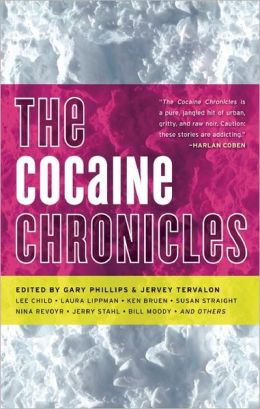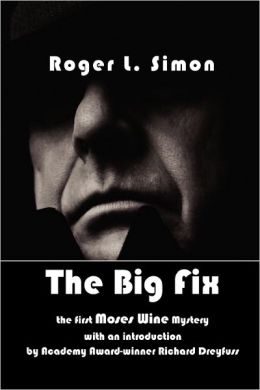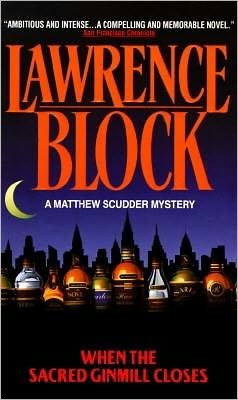 Sherlock Holmes, the spiritual father of the private eye hero, was a user himself, much to Dr. Watson’s dismay. Or did you think he was knitting when he bellowed to the good doctor for the needle?
Sherlock Holmes, the spiritual father of the private eye hero, was a user himself, much to Dr. Watson’s dismay. Or did you think he was knitting when he bellowed to the good doctor for the needle?
Photo: Jaimie D. Travis
“Sleuthing is not the most rewarding work. However, being a drug addict has its charms.”
—New York eye Dick Shamus in Jon Hammer’s The Drowned Girl (1990)
Lately, I’ve been digging The Cocaine Chronicles (2005, Akashic Books), Gary Phillips and Jervey Tervalon’s head-twisting new collection of coke-filled short stories from some of today’s leading crime-fiction writers and other miscreants, a selection of hard, uncut hits that go directly to the brain. Several brand name PI authors are present and accounted for: Laura Lippman, Lee Child, Ken Bruen, and that big ol’ editing rascal, Gary himself. They lay out some extremely satisfying (and often very funny) lines of product, but surprisingly, and even a bit disappointingly, none of the stories in Chronicles features their series characters.
That doesn’t mean that the world of fictional private eyes is some sort of drug-free never-never land, though. In fact, right from the beginning, the use (and frequent abuse) of drugs, both legal and otherwise, has been a staple of the genre—and definitely not just by the bad guys. As the epigraph- featured quote from Sir Conan Doyle’s The Sign of Four so gleefully points out, Sherlock Holmes, the spiritual father of the private eye hero, was a user himself, much to Dr. Watson’s dismay. Or did you think he was knitting when he bellowed to the good doctor for the needle?
And ever since, private eyes have drunk, dropped, popped, sniffed, snorted, and injected themselves into various states of consciousness, with little apparent regard for their own health or any passing laws of the land. Heck, the hard-boiled private eye we all know and love was born right smack dab in the middle of Prohibition (a.k.a. “The First Great War on Drugs to End All Wars on Drugs”), the first in what would be a continuing series of expensive, misguided, and doomed attempts to legislate social behavior by threatening to throw people in jail. Of course, Prohibition didn’t work—instead it made the selling of outlaw hooch so lucrative that we ended up with (even more) widespread political corruption and saw small, generally unorganized criminal gangs transformed into mighty crime syndicates whose descendants—both spiritual and direct—have profited mightily from each subsequent war on drugs.
 So, even when those hard-boiled Prohibition-era gumshoes were out there dispensing justice, their .45s blazing away in the pages of Black Mask and other pulps of the time, the hip flask was never far away (nor was it all that far from the blazing typewriters of the creators themselves, come to think of it). As Rita Elizabeth Rippetoe asserts in her fascinating and enlightening Edgar-nominated study, Booze and the Private Eye: Alcohol in the Hard-Boiled Novel (2004, McFarland & Company), “the treatment of alcohol within the works informs and illustrates the detective’s moral code, and casts light upon the society’s attitudes towards drink.”
So, even when those hard-boiled Prohibition-era gumshoes were out there dispensing justice, their .45s blazing away in the pages of Black Mask and other pulps of the time, the hip flask was never far away (nor was it all that far from the blazing typewriters of the creators themselves, come to think of it). As Rita Elizabeth Rippetoe asserts in her fascinating and enlightening Edgar-nominated study, Booze and the Private Eye: Alcohol in the Hard-Boiled Novel (2004, McFarland & Company), “the treatment of alcohol within the works informs and illustrates the detective’s moral code, and casts light upon the society’s attitudes towards drink.”
Well, yeah. And that goes for other substances, as well, for the private eye genre has always functioned best as a chronicle of contemporary times, and is therefore always in a state of flux when it comes to its attitudes.
In Red Harvest, Dashiell Hammett’s Continental Op takes a break from playing two rival gangs off against each other by swilling a concoction of gin and laudanum, no doubt to demonstrate the manly resolution of his hard-bitten, tough-minded nature.
Meanwhile, Jonathan Latimer’s Bill Crane drank for a much simpler reason: he enjoyed it. In the course of five delightfully screwball novels in the early ’30s, Crane enjoyed just about anything he could get his hands on—including at one point embalming fluid—and spends most of his time either high as a kite or suffering from a hangover.
But hey, it was all in “good fun,” the effects of such abuse ignored or more characteristically, played for laughs. Drunkenness and hangovers were a reliable comedic staple in lighter-hearted fare for decades to come (cf. Dean Martin), a tried-and-true laugh-getter in such detective fiction as The Thin Man by Hammett, the Shell Scott series by Richard Prather, and the J.J. Malone series by Craig Rice. More serious-minded novels, meanwhile, generally treated excessive drinking as the weakness of lesser men or, in the cases of the heroes themselves, merely the reasonable response of a sensitive soul to carrying the weight of a corrupt, uncaring world on his trench-coated shoulders, the omnipresent office bottle already halfway to cliché by the time Sam Spade and Philip Marlowe came along.
It would be years before the boozing would be allowed to take its toll of the fictional eye, and then in a hand-wringing, rather romantically tragic way, one of the first instances being Wade Miller’s Max Thursday, who’s introduced to us in Guilty Bystander (1947) as only a step or two above skid row, working as a flophouse dick. Ed McBain’s Curt Cannon, a private eye turned Bowery bum, appeared in several, often brutal, short stories and a novel a few years later.
 Even good ol’ Mike Hammer went off the deep-end. When he makes his entrance in The Girl Hunters (1962), ten years after his last adventure, he’s been on a seven-year bender, mourning the loss of his beloved Velda. But of course he cleans himself up when he learns that Velda is still alive and in serious need of rescue. It’s worth noting that redemption and sobriety were always close at hand and easily achieved for the soused shamuses of the era. Hammer, for example, drinks as much as ever in his subsequent adventures, with no mention of his alcoholism, an apparently optional malady one could simply choose not to suffer from.
Even good ol’ Mike Hammer went off the deep-end. When he makes his entrance in The Girl Hunters (1962), ten years after his last adventure, he’s been on a seven-year bender, mourning the loss of his beloved Velda. But of course he cleans himself up when he learns that Velda is still alive and in serious need of rescue. It’s worth noting that redemption and sobriety were always close at hand and easily achieved for the soused shamuses of the era. Hammer, for example, drinks as much as ever in his subsequent adventures, with no mention of his alcoholism, an apparently optional malady one could simply choose not to suffer from.
Ah, if only it had been so easy for Lawrence Block’s Matt Scudder. When the hangover of reality finally caught up with the genre, it did so with a vengeance. Scudder was a cop who quit the NYPD to drown his guilt over a bad shooting in the first five novels of the series, before finally coming to grips with his alcoholism at the end of Eight Million Ways to Die (1982)—redemption, perhaps, but at a painfully realistic price, for once. The series has gone on to other heights, with the recovering detective never too far from an AA meeting, but those first five, the great Lost Weekend of PI fiction, still pack one harrowing wallop of wretchedness and grim despair.
Not, of course, that booze is the only evil to appear in the genre, the ridiculous and often paranoid demonization of assorted controlled substances (Reefer Madness, anyone?) of the ’30s, ’40s, and ’50s gradually giving way to a more tolerant or at least informed approach, so that by the ’70s, Roger Simon’s hippie dick, Moses Wine, could smoke a joint and enjoy a good game of solitary Clue in the 1973 classic The Big Fix without the world coming to an end. And in his wake came a steady stream of dicks who would cop to having inhaled, including G.M. Ford’s Leo Waterman, Richard Stevenson’s Don Strachey, and L.A. Morse’s octogenarian Jake Spanner who in 1981’s The Old Dick summed it all up neatly with the rhetorical musing, “Kids today think they invented this stuff?”
But it went beyond pot. Holmes may have favored his beloved seven percent solution, but he’s certainly not the only one to have put stuff into his body that probably shouldn’t be there. Don’t bet on current superstar eyes like George Pelecanos’ Nick Stefanos, Ken Bruen’s Jack Taylor, or James Crumley’s dynamic duo of Milo Milodragovitch and C.W. Sughrue (now appearing in the long-awaited The Right Madness) or currently MIA eyes like Zachary Klein’s Matt Jacob and Michael Cormany’s Dan Kruger (where the hell are they, anyway?) passing any urine tests any day soon. These guys are all equal opportunity substance abusers. Booze, pot, coke, pills—you name it, and these guys will try it—and more than once.
 Nor is the willful use of all these wondrous concoctions restricted to the gentlemen of the genre—for example, Greg Rucka’s Bridget Logan shows it’s no different for girls by descending into heroin addiction to crack the case in the pulpy provocation of Shooting at Midnight (1999).
Nor is the willful use of all these wondrous concoctions restricted to the gentlemen of the genre—for example, Greg Rucka’s Bridget Logan shows it’s no different for girls by descending into heroin addiction to crack the case in the pulpy provocation of Shooting at Midnight (1999).
Yeah, right... Of course, we all know drug abuse isn’t really heroic or funny, and in these oh-so-correct times, it’s seldom played for laughs. But there’s something darkly funny about us waging an increasingly self-righteous and costly war on drugs while the airwaves are saturated with Super Bowl beer commercials aimed at 12-year-olds, and one of Matt Scudder’s fellow travelers sits in the Oval Office. Oh, sure, the increasingly self-righteous can all pat themselves on the back for having deadly pot desperado Tommy Chong (of Cheech & Chong) cooling his heels in the hoosegow (for selling pipes on the internet), but there’s more opium coming out of Afghanistan than ever. Back on the home front, Junior’s on Ritalin, Dad’s had three scotches for lunch, and Mom can’t wait to go running for the shelter of her mother’s little helpers. We love our drugs; we just don’t like to admit it.
So it’s no biggie that the private eye has indulged in various substances over the years—and will in all likelihood continue to do so. Sometimes he (or she) will handle it, sometimes he’ll just say “No.” And sometimes he’ll just be an asshole. Like the rest of us. At its best the genre has always cast a hard and unflinching eye on our society; on all our embarrassing little quirks and hypocrisies and foibles. Including our ambivalence towards drugs. I remember a few years ago, some woman on some online discussion group solemnly announcing her personal boycott of any books where any character, but especially the detective, partakes of any illegal substance—or even tobacco. She was urging others to join her.
Get over it. That raucous laughter you hear is Philip Marlowe’s, as he pours another shot from the office bottle.
Cheers.
This article first appeared in Mystery Scene Summer Issue #90.


